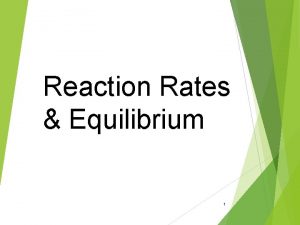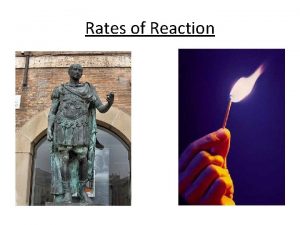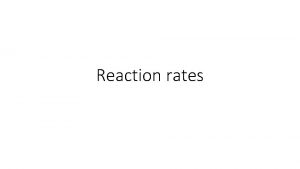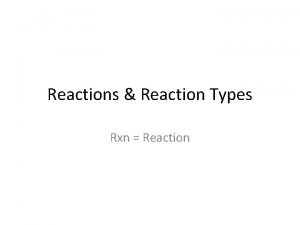Measuring Rates of Reactions Rates of Reaction The








- Slides: 8

Measuring Rates of Reactions

Rates of Reaction � � � The rate of a chemical reaction is the speed at which the reaction occurs (i. e. speed at which the reactants are used or products are produced). Rate can be measured by the: 1) change in mass of reactants or products. 2) change in p. H 3) change in conductivity (ion production) 4) change in colour (intensity of colour) 5) change in temperature 6) production of a gas The factors that will affect the rate of a reaction are: 1) Temperature 2) Surface Area 3) Concentration 4) Catalyst 5) Chemical Nature of Reactants 6) State of the Reactants

Chemical Reaction Rates � The reaction rates of chemical reactions are the amounts of a reactant reacted or the amount of a product formed per unit time, (moles per second). Often, the amount can be expressed in terms of concentrations. � A realistic representation for a reaction rate is the change in concentration per unit time, either the decrease of concentration per unit time of a reactant or the increase of concentration per unit time of a product. In this case, the rate is expressed in Mol/(L sec).

Measuring Reaction Rates � To measure a reaction rate, we usually monitor either a product or a reactant for its change. � Any physical characteristic related to the quantity or concentration of a product or reactant can be monitored. � Some of the characteristics to be monitored are: change in pressure change in color (spectroscopic measurement) temperature for exo or endothermic reaction presence of certain key substance

� The change can be plotted on a graph, and from the graph, we can get the average rate or the instantaneous rate by graphical analysis.

Average Rate � rate measured between long time interval (slope of secant)

Instantaneous Rate � rate measured between very short interval (slope of tangent)

Practice � Read section 6. 1 � Page 350 #1 � page 352 #1 � Page 356#1, 2 � Page 360 #1, 2
 Chemistry unit 5 reactions balancing reactions worksheet
Chemistry unit 5 reactions balancing reactions worksheet How to write a balanced redox reaction
How to write a balanced redox reaction Section 2 reinforcement classifying chemical reactions
Section 2 reinforcement classifying chemical reactions Chemical reactions section 3 reactions in aqueous solutions
Chemical reactions section 3 reactions in aqueous solutions Section 2 classifying chemical reactions
Section 2 classifying chemical reactions Ratios rates and unit rates
Ratios rates and unit rates A rate is a ratio that compares
A rate is a ratio that compares Ratios and proportions guided notes
Ratios and proportions guided notes Ratios rates and unit rates
Ratios rates and unit rates















